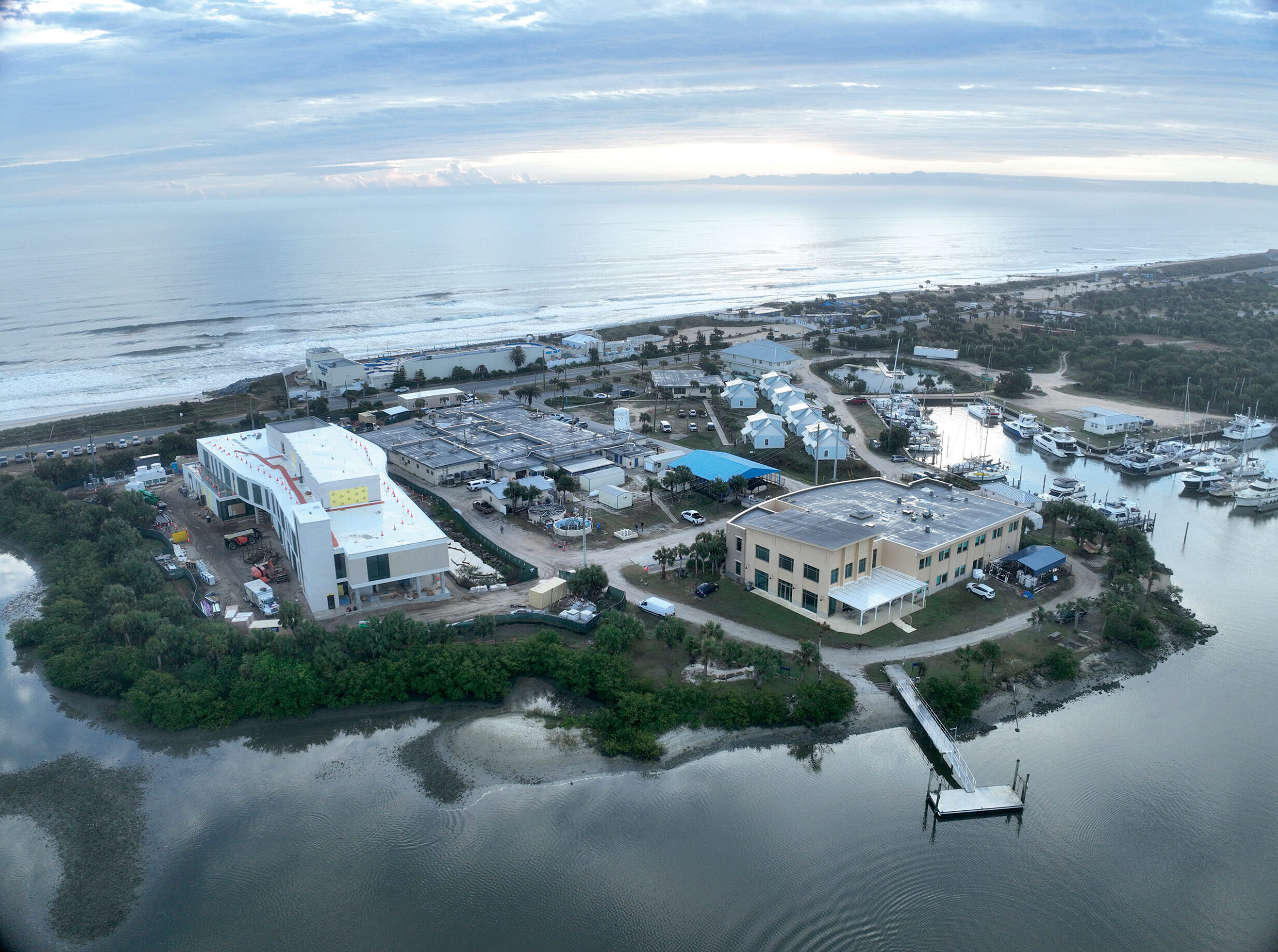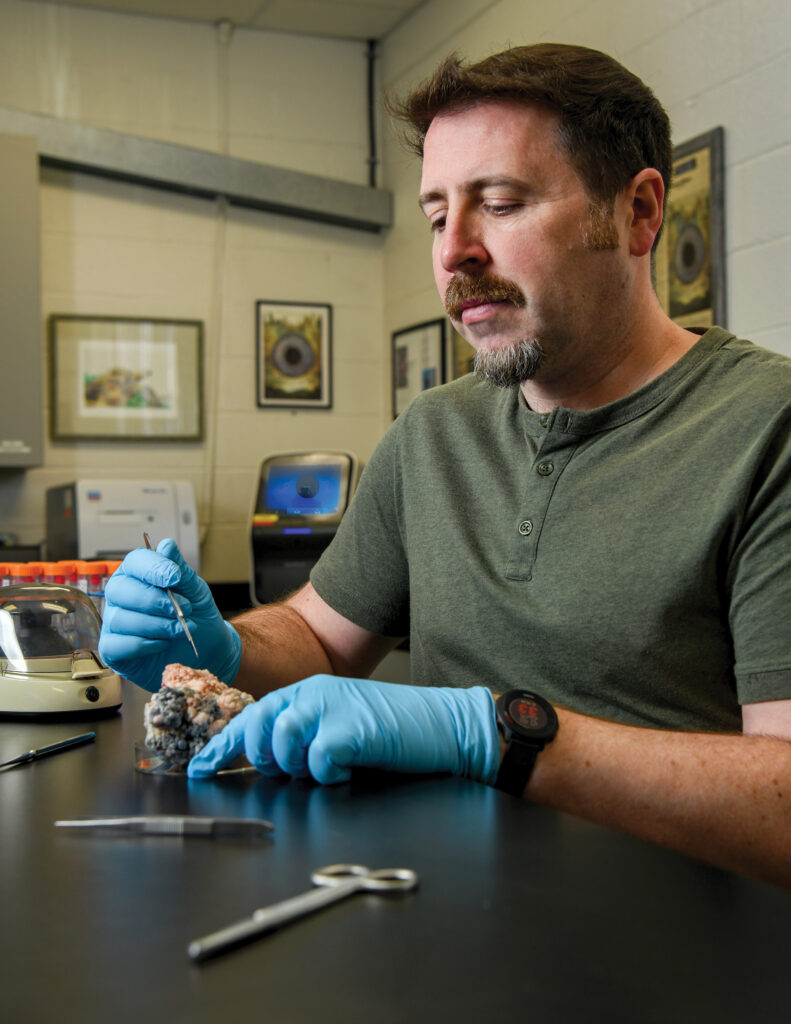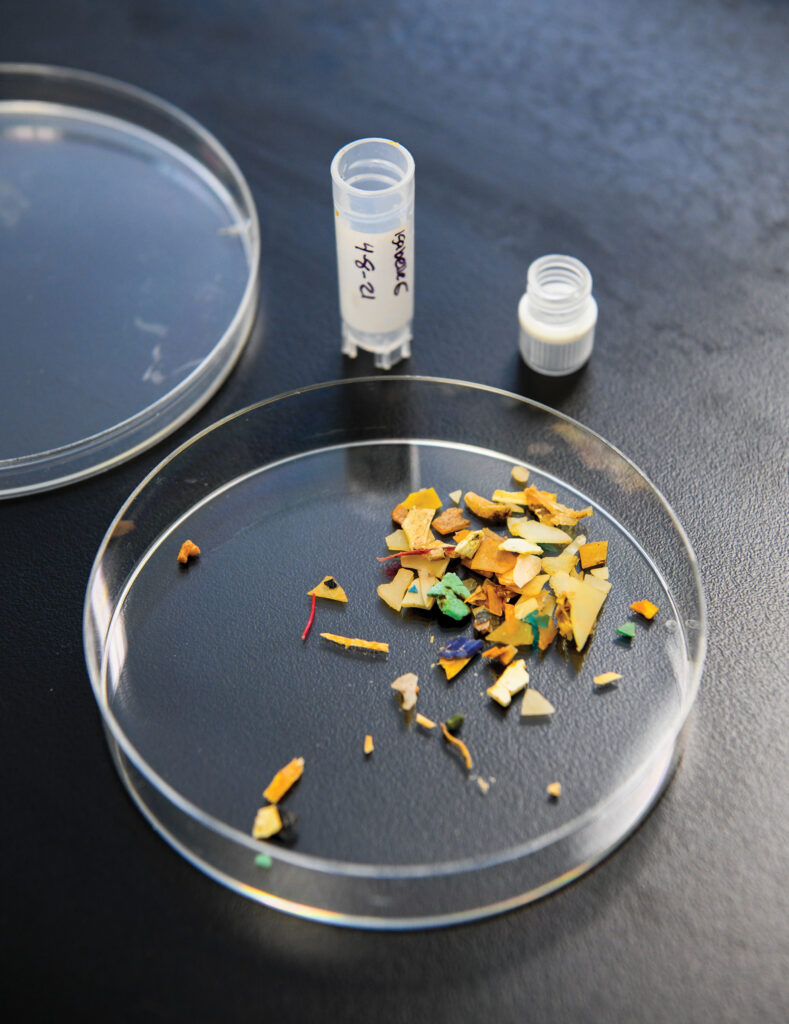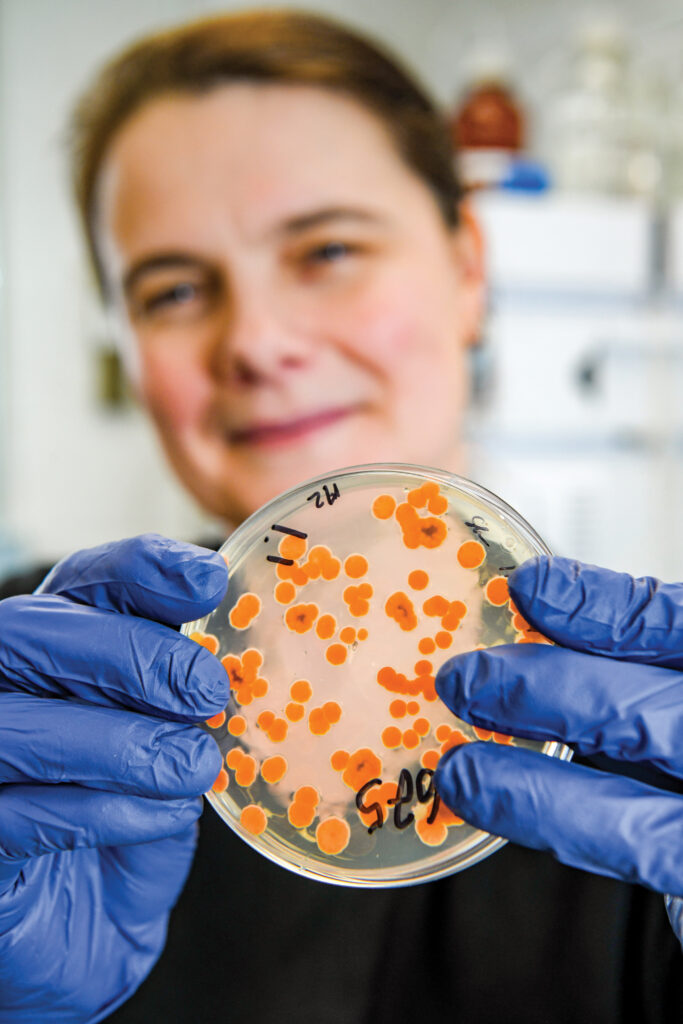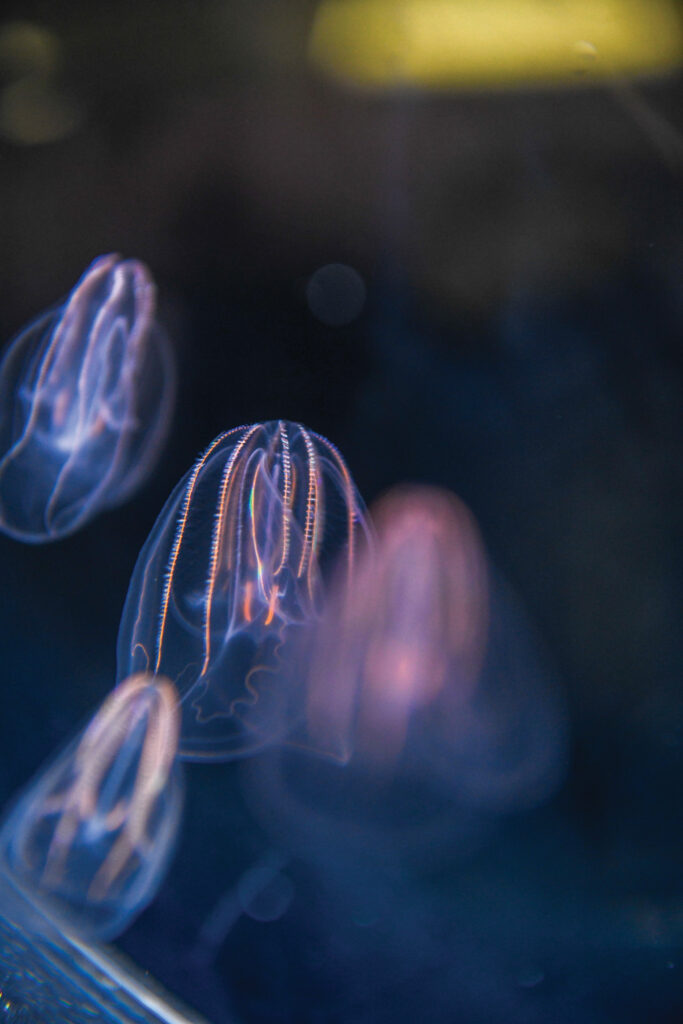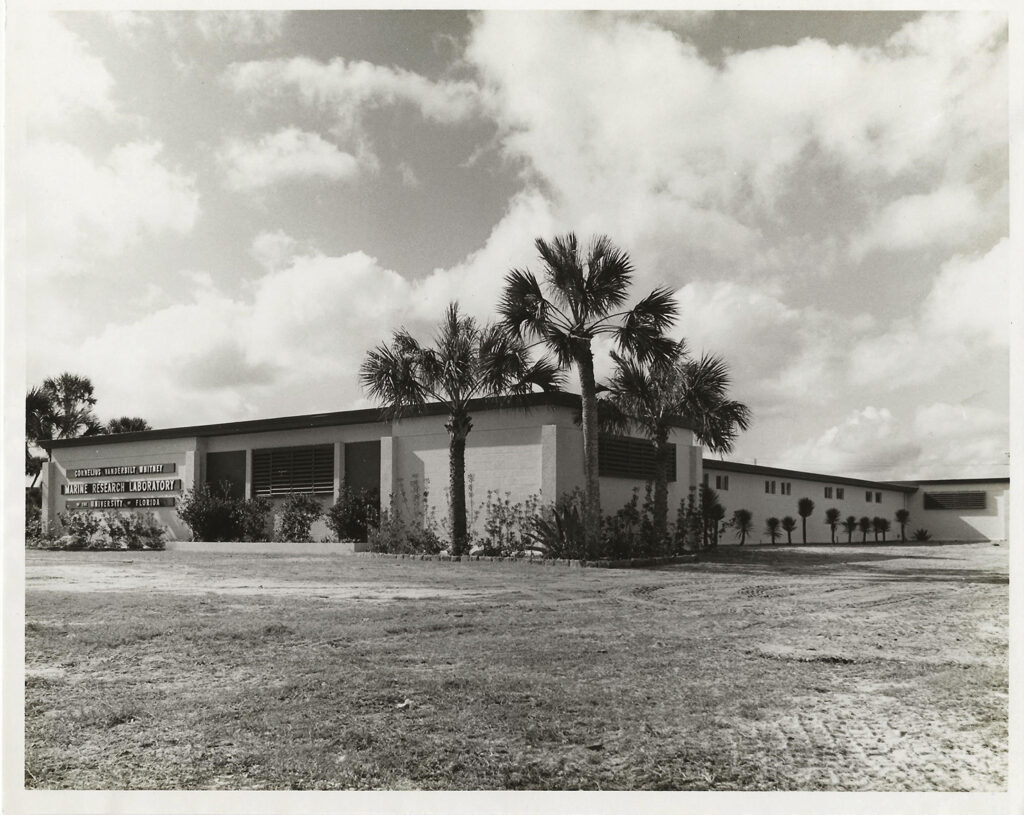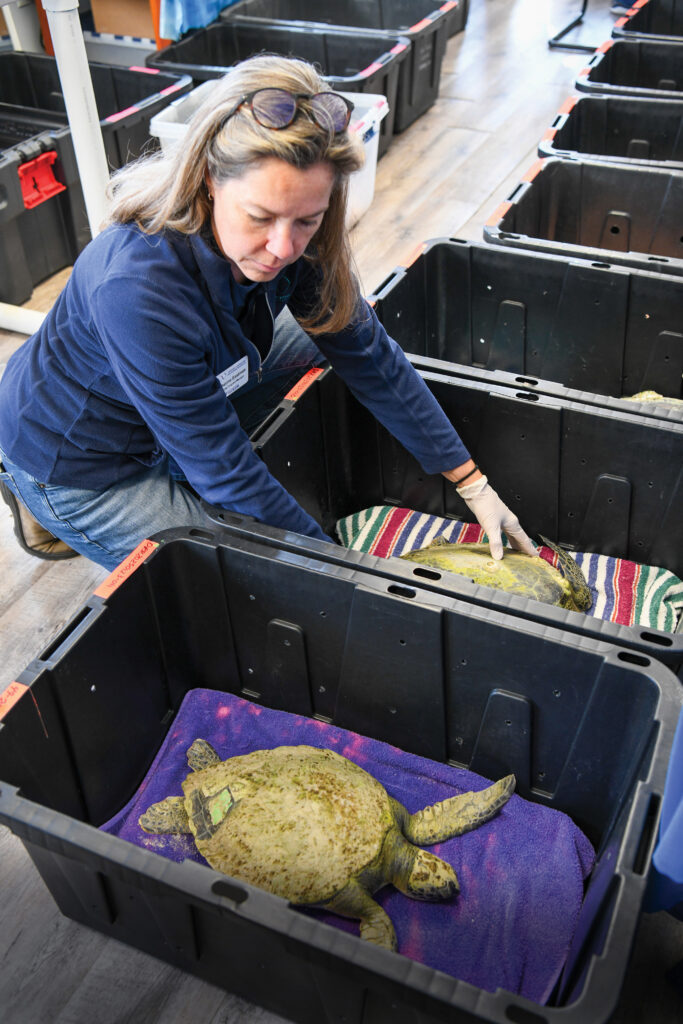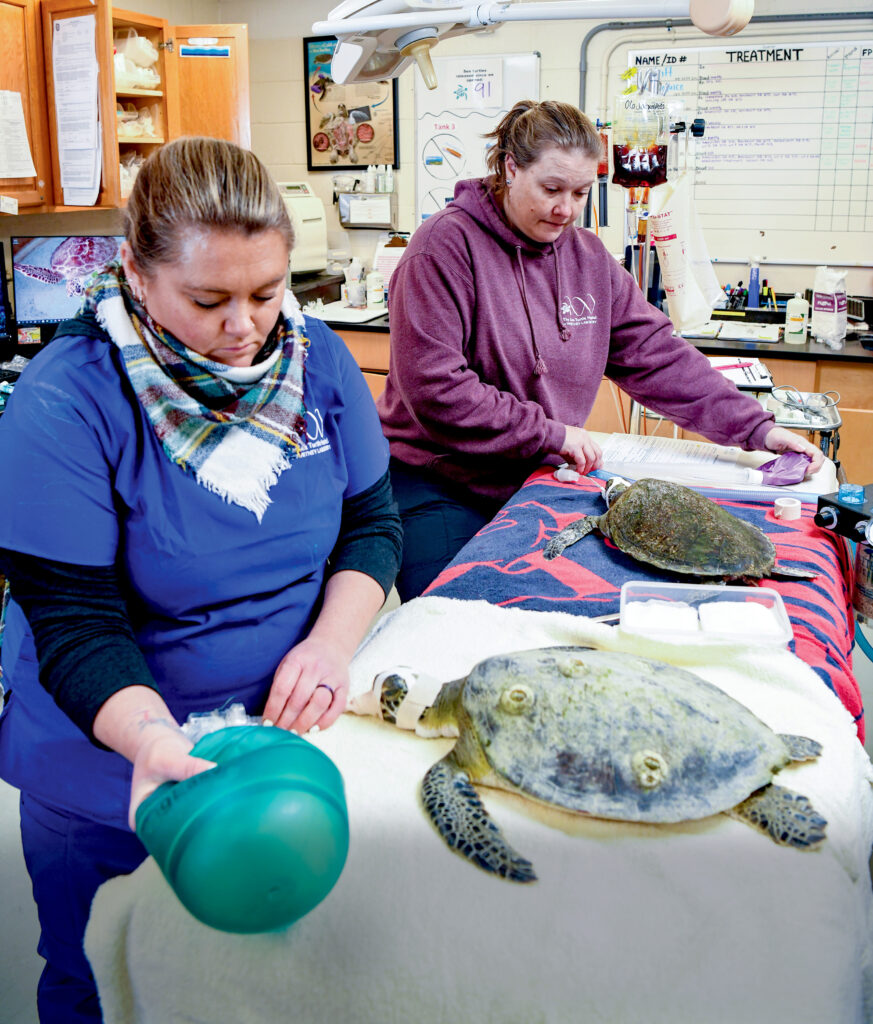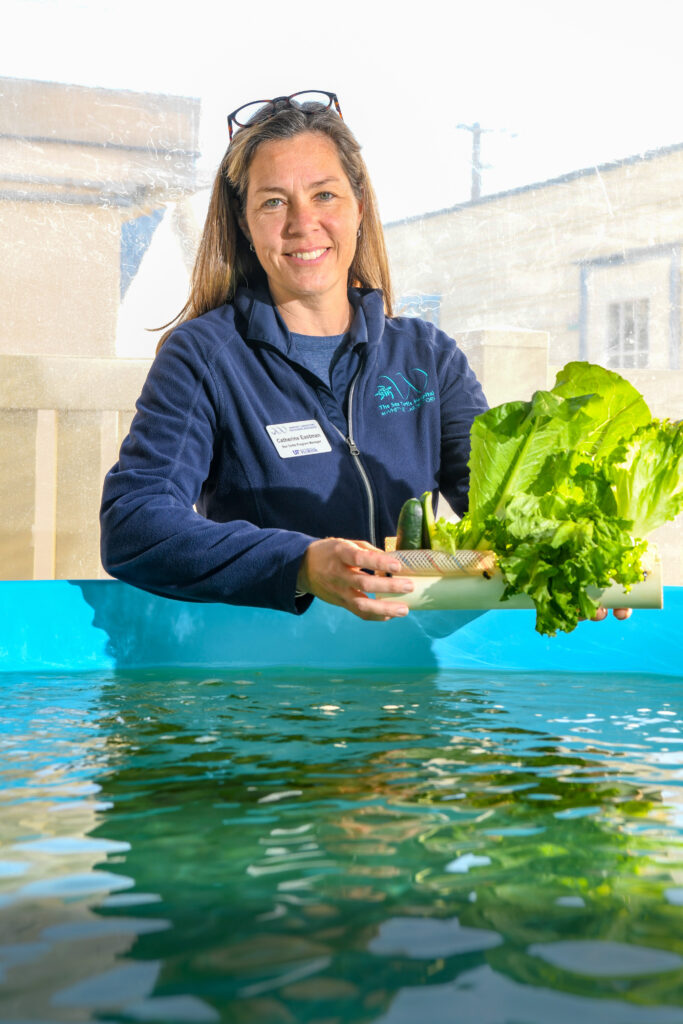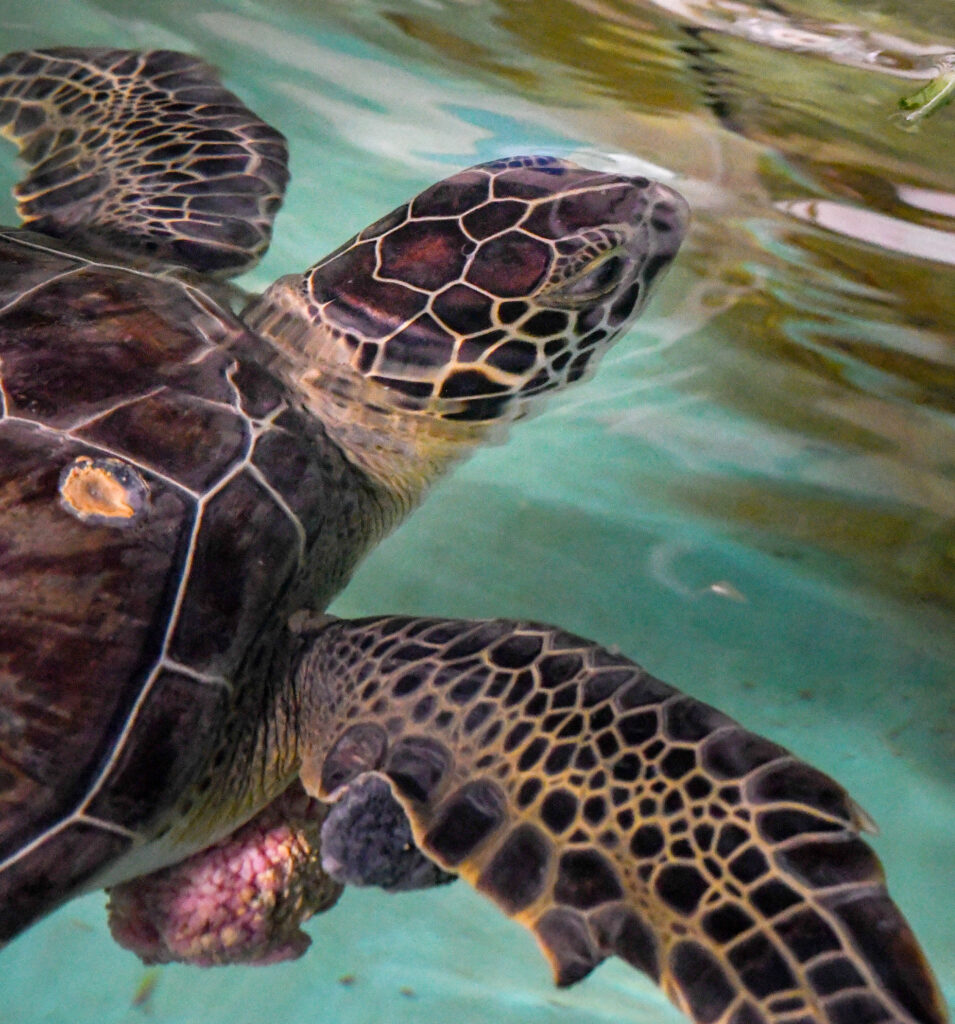David Duffy holds up a half-full vial of multicolored plastic shards, each one smaller than a grain of rice. In a drawer in Duffy’s lab, rows of other plastic-filled vials line a tray.
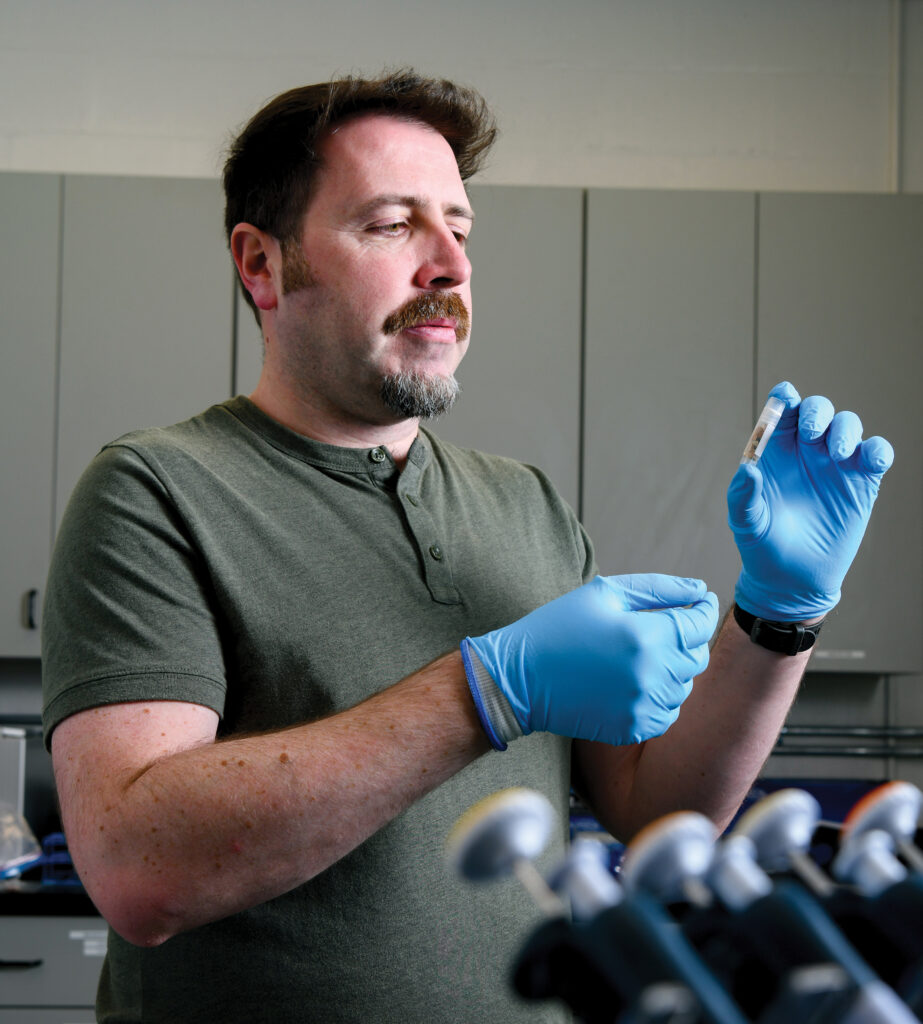
All the plastic came from sea turtles treated at the University of Florida’s Whitney Laboratory for Marine Bioscience. For Duffy, a molecular biologist, it vividly illustrates the urgency and importance of Whitney’s mission.
Necropsies on the young turtles that washed back to shore and didn’t survive tell the grim tale. Almost all of them had plastic in their intestinal tracts.
“It wasn’t just one or two pieces of microplastic. Some of them had hundreds of pieces, sometimes one-quarter of their body length,” Duffy says.
As the Whitney Lab enters its sixth decade and a new $41.2 million, 38,000-square-foot research facility nears completion at its waterfront campus south of St. Augustine, Duffy and his colleagues see a pivotal moment. Whitney, they say, is poised to build on its world-class reputation for developmental biology and the genetics of marine animals. The lab has added to its scientific portfolio in recent years, bringing in Duffy along with experts in aquaculture and natural-products drug discovery. Veronica Hinman, a renowned expert in the biology of regeneration in marine animals, joined the lab in January as its new director.
Whitney, Duffy says, is distinguished by its location and ability to do both field research and advanced molecular biology — a capability matched by few other marine labs. Its facilities are nestled at the edge of more than 75,000 pristine acres of marine estuary and just steps from the Atlantic Ocean.
“We’re based in the same environments we are studying and the same habitats where our sea turtle patients live. We’re right there at the intersection of some big issues in the environment,” Duffy says.
The driving force behind the Whitney Lab was Sam Gurin, a UF biochemistry professor who realized in the 1960s that much of the important research into embryo development and nerve function was taking place at marine labs. His vision for a year-round, marine biomedical research facility was shared by Cornelius Vanderbilt Whitney, one of the founders of the adjacent Marineland oceanarium. Whitney noted marine animals didn’t seem to suffer from the same ailments as humans. He posed a big question: What can marine animals teach us about the origins of human diseases?
Whitney donated two acres of land in the town of Marineland and half of the construction costs to UF. With that, his namesake lab debuted in 1974.
Detecting DNA, Tracking Cancer
Duffy brings a specialized skill set to the Whitney Lab that includes proficiency in sea turtle tumors and plastic ingestion. He also has expertise in environmental DNA, or eDNA, which reveals troves of new information about wildlife populations.
While Whitney is steeped in a tradition of developmental biology, Duffy says he was attracted to its pioneering spirit. When he arrived as a postdoctoral researcher in 2015, the sea turtle hospital was brand new. He floated an ambitious idea: Take what was known about human cancer treatment and apply it to sea turtles.
Duffy and his colleagues eventually found genetic similarities between the proteins in fibropapilloma, which causes fast-growing tumors in turtles, and the proteins that spawn basal cell skin cancer in humans. An anticancer drug used in humans knocked down the tumor recurrence in turtles from 60% to 18%, the researchers found in 2018.
“It was very much a case of ‘Let’s see how this goes,’” Duffy says. “And it went very well.”
Now, he’s using genomic sequencing to sort through the many factors that drive tumor growth in sea turtles. One of those elements is the environment: In open areas with good water flow, tumors might occur in about 10% of turtles. Just a few miles away in water that’s more contaminated or less free flowing, tumor prevalence can reach 80%. Duffy’s tumor research involves profiling those growths in individual turtles, determining common mutations and identifying the genes that are responsible.
“As we start to understand those mutations, we can better understand the causes and identify treatments that could be effective,” he says.
Duffy is also at the forefront of using eDNA to identify and count animals in the wild without ever seeing them. Traditional animal surveys are expensive and time consuming. Assessing individual sea turtles also requires enough good weather — and luck — to capture one. Now, about a quart of seawater is all that’s needed.
The technique is similarly effective for land and air samples. With less than a half-pint of river water, Duffy has shown that thousands of species can be identified — including enough detail to reveal the genetic ancestry of humans who have been in the area.
“The real benefit of eDNA for species identification is that you can take a water sample and see what’s in the area without ever having to observe a species. They’re leaving behind these tell-tale traces of DNA for us,” says Duffy, an assistant professor of wildlife disease genomics.
For Duffy, his work on microplastics in juvenile sea turtles is just as compelling — and much more sobering. Nearly 93% of post-hatchling loggerhead turtles that were studied for a 2020 paper had plastic in their guts, typically rigid plastic and sheet fragments. The prevalence of plastic in young turtles far surpassed what had been found by other researchers.
“It was absolutely shocking,” Duffy says.
For juvenile turtles, their first haven can also be their downfall. After hatching, they make an exhausting swim to the Sargasso Sea, a floating seaweed mass east of Florida. The microplastic there is especially pernicious. In open water, plastic absorbs other chemicals from the environment as it breaks down into pieces that turtles mistake for food. Intestinal ruptures and stomachs crowded with plastic are common among Whitney’s turtle patients.
Duffy notes that the original idea to study the plastics issue came from the sea turtle hospital. That research, he says, was facilitated by the full range of Whitney’s capabilities, from providing a site to shelter stranded turtles to conducting necropsies and scientific analysis of the plastics.
“This is a huge problem and we are continuing to study it,” Duffy says.
Decoding Nature’s Healing Powers
The world is Sandra Loesgen’s laboratory. From the Matanzas River that flows past the Whitney Lab to the farthest reaches of Antarctica, she samples the Earth for microbes that can become medicines.
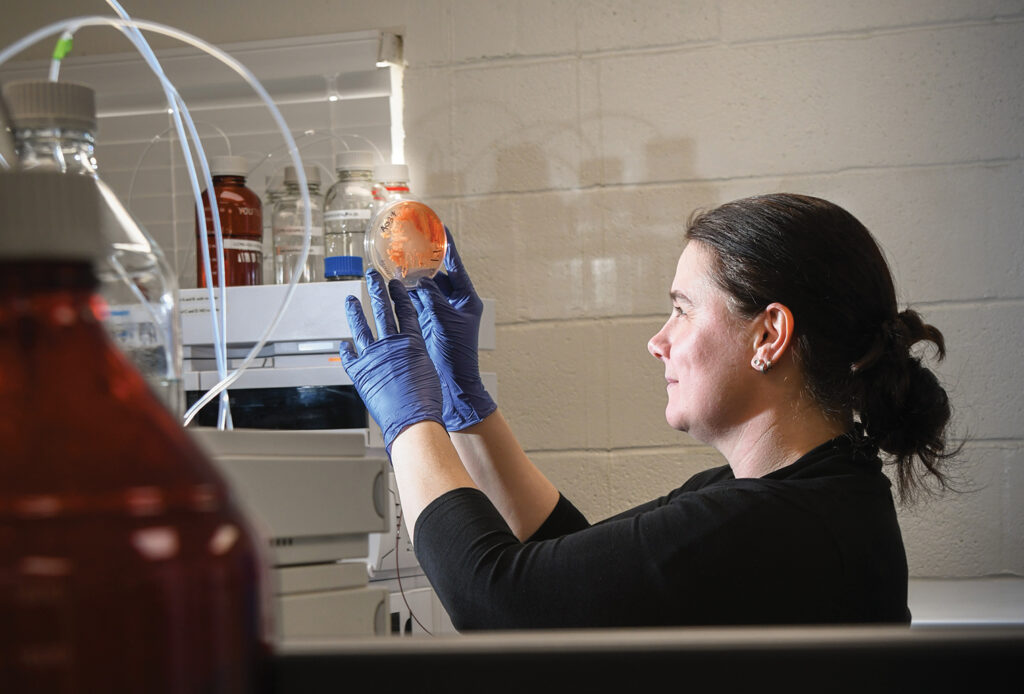
Loesgen speaks passionately about the elegance, mystery and potential that nature bestows on chemical compounds. Still, it’s a career that almost didn’t happen. Loesgen initially planned to be a doctor, but a hospital internship delivered an epiphany.
“I thought about why I was really interested in medicine. I decided it was actually the science behind it — how the body functions and how we treat diseases,” she says.
Loesgen pivoted to chemistry and, before long, had another choice: Spend her years synthesizing organic molecules or parsing the compounds made by nature. She listened to her gut instinct.
“I decided I wanted to be the person discovering natural compounds,” she says.
Loesgen, an associate professor of chemistry, has spent nearly six years at Whitney. Unlike some scientists, her work doesn’t focus on one disease or disorder. Loesgen’s research cuts across cancer, viral infections and pain suppression. Her specimen library is immense, a room-sized cooler brimming with a technicolor collection of more than 8,000 strains of bacteria and fungi.
Loesgen pursues what she calls “chemically talented” microbes, particularly ones that live symbiotically within algae or other hosts. Interpreting the “chemical language” that drives that interaction is what can ultimately uncover medicinal compounds.
“Nature gives us these molecules and it’s up to us to determine what they can do,” Loesgen says.
That has included identifying a soil-dwelling bacterium that strongly inhibits the growth and movement of melanoma cells, a dangerous skin cancer that often spreads throughout the body. The bacterium kills the cells by attacking their energy metabolism. That work has now shifted from cell research to mice.
In mid-2024, Loesgen and her colleagues showed that a fungus derived from marine algae selectively targets triple-negative breast cancer cells. The disease accounts for only about 20% of all breast cancer cases but is difficult to treat and carries the highest mortality rate. Her team identified a chemical compound within the fungus that inhibited the cancer cells with varying potency. More broadly, the researchers concluded that the fungus and others like it are worthy of further study.
For Loesgen, the Whitney Lab is also a scientific asset because it fosters collaborations between researchers within its campus and throughout UF. One of her newest projects involves working with James Strother, an assistant professor of biology at Whitney, on pain research. Microbes from Loesgen’s lab are being studied for potential pain relief in Strother’s zebrafish. It’s the first step in a lengthy process of developing non-opioid painkillers for humans. In the lab, Loesgen’s experience with small molecules and chemistry meshes with Strother’s expertise in systems neuroscience.
“We need new painkillers without the addiction potential of opioids,” she says.
New Leadership
In the late 1980s, Veronica Hinman was deep into her mechanical engineering studies at the University of Queensland. She decided to take an introductory class in ecology and evolution. A string of professors, teaching a few weeks at a time, left an indelible impression.

“I was just blown away. This is someone’s job to go and do these incredible things with science,” Hinman says.
She finished the engineering degree and immediately went back to school for bachelor’s and doctoral degrees in zoology. Her work at a marine biology research station on Australia’s Great Barrier Reef validated the academic pivot.
“I was pulling up plankton and the embryonic forms of corals and worms and sea cucumbers. It felt like a whole different planet. I became really fascinated by animal diversity and its origins,” she said.
Hinman went on to a postdoctoral fellowship at the California Institute of Technology, working with one of the world’s most pioneering and renowned developmental biologists. That led to a nearly 20-year career at Carnegie Mellon University, where she eventually led the biology department and specialized in evolutionary development — how genes control the progression of embryos and how those processes evolve. She’s also worked extensively on gene regulatory networks, the complex molecular machinery that controls the minutia of gene expression in cells.
In January, Hinman added a new title to her resume: the sixth director of the Whitney Lab.
Whitney, Hinman says, has everything she was looking for: A faculty that’s strong in her scientific specialties, an ideal location for marine research and deep connections to the community. Like her predecessor, Hinman will serve as an administrator and researcher. Her lab uses advanced imaging and genetic tools to learn how starfish “reprogram” their cells to enable tissue regeneration — a key step in developing wound healing techniques and new degenerative-disease treatments for humans.
Hinman says Whitney’s unique environment will also allow her to explore new research questions, such as how local marine species thrive in challenging conditions including major salinity and temperature changes. She’s especially curious about how embryos develop and stay healthy in difficult marine environments.
“This work is important because it can help us learn how marine life might cope with climate change and give us clues about protecting biodiversity in a changing world,” she says.
For Hinman, that means maintaining Whitney’s traditional strength in evolutionary and developmental biology while looking for new or growing research opportunities in fisheries, aquaculture and natural products drug discovery.
“Whitney’s location alone is a very powerful draw,” Hinman says. “There are many novel compounds that could boost drug discovery. The ocean is going to reveal a lot of secrets to us.”
Leaving His Mark
Mark Q. Martindale, a developmental biologist, spent a dozen years in two key roles — running his lab while also serving as Whitney’s director.
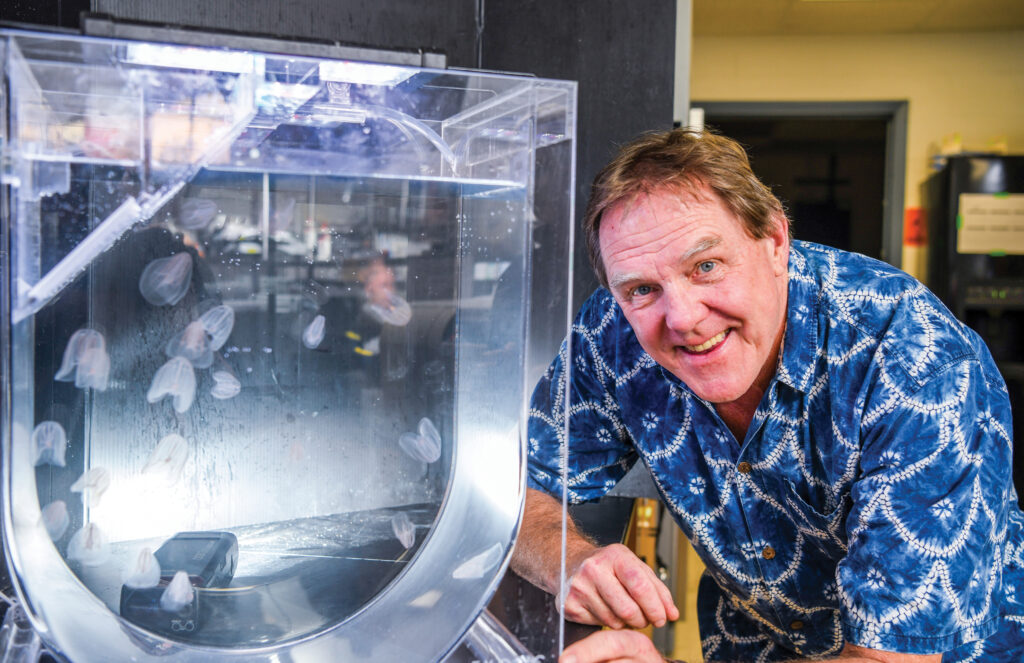
It didn’t take much to lure Martindale from the University of Hawaii. UF leadership showed an intense interest in the Whitney Lab from day one, Martindale says. Then, there was the location.
“The Whitney environment has a very different set of plants and animals along with tidal influences and water salinity issues. If you’re a biologist, this is like being a kid in a candy store. Every day, we feel like we’re in the middle of a living laboratory,” he says.
Martindale recruited nine of the 11 current faculty members, with a focus on diversifying Whitney’s research profile. Building on its early strengths in neurobiology — sensory biology in particular — Martindale helped broaden Whitney’s faculty to include specialists in aquaculture, environmental DNA and natural products drug discovery.
Soon, the Whitney Laboratory will be much larger and more state of the art. Martindale calls the Marine Research Institute building a “new front door” for Whitney: Many researchers will have fresh space, trading their quarters in a low-slung, sprawling building for labs with sweeping views. It was seeded with a $5 million private donation, which was immediately matched by UF with the rest coming from the state and additional donations.
Whitney’s most public-facing asset — the Sea Turtle Hospital — is also moving into the new quarters. Visitors will be able to look into “sea turtle suites,” observing the animals as they undergo rehabilitation and medical treatments. Drop-in guests will get better views of the turtles while experiencing fresh displays explaining Whitney’s many scientific efforts. Gone are the days when an approaching hurricane meant evacuating all sea turtle patients, a complex ordeal that temporarily scattered them to other marine facilities or staff members’ homes.
For decades, Whitney’s faculty was well known for expertise in neurobiology — the way sensory organs and neurons work together to help creatures navigate their environments. Yet its scientific legacy is also broad and distinctive: Barbara-Anne Battelle, an emeritus professor of neuroscience, used horseshoe crabs to understand how molecular “timers” help light-sensitive eye cells adapt to changing levels of brightness. Those mechanisms are crucial for normal vision in many animals. The late Michael J. Greenberg, a former Whitney director, made pioneering discoveries about specialized molecules that control heart rhythm in a common clam species.
Now, Martindale says, Whitney’s strengths also include developmental biology and learning how marine animals’ genes interact with each other and the environment.
With the new marine research building nearing completion, Martindale says it’s a good time for yet another change. At the end of 2024, he returned to full-time research.
In his lab, the gregarious Martindale hits a whole new level of ebullience. He points to a tank of jellyfish with a mix of awe and curiosity. The comb jellyfish, Martindale says, has remarkable regenerative powers. Learning more about how its cells behave and reorganize during wound repairs is a path to better understanding the biology of regeneration.
“I’m looking forward to spending more time with the people in my laboratory, brainstorming and thinking about the next big thing,” he says.
For now, that means using a particular jellyfish as an experimental model to study coral bleaching. He’s also intensely interested in biomineralization, the process that converts minerals into bones, teeth and shells.
Martindale has a three-year, $1 million National Science Foundation grant to develop Cassiopea xamachana, commonly known as the “upside down” jellyfish. During a bleaching event, a symbiotic alga that allows the coral to thrive is expelled. But even studying the problem is a challenge: Corals are endangered and don’t respond well to lab life. That’s where Martindale came in, developing a way to use the jellyfish’s gut to replicate the alga’s relationship with coral. Tracking that cooperative relationship could provide crucial information for restoring coral reefs.
For Martindale, decoding the secrets of biomineralization is a path toward sturdier materials and, perhaps someday, healthier people.
“No engineer can make a substance that’s as strong as a snail’s shell,” he says.
He recently started working with a Mayo Clinic cardiologist who studies calcium buildup in heart arteries. One idea is to use the same molecules Martindale studies in sea anemones to remove harmful, calcifying proteins from humans’ blood. That concept, Martindale says, embodies the founding spirit of the Whitney Lab.
“The idea is to learn from nature about how things work so that they can be utilized to impact human health,” he says.
Humble Beginnings
When Barry Ache joined the Whitney Lab in 1978, it was exactly what he wanted — the chance to do full-time research in a marine lab. Back then, the Whitney Lab consisted of just three people: Ache, the part-time director and a zoology researcher from Gainesville.
Ache recalls his early years at Whitney as a “very, very fun place to be.” The lab was run by the UF Foundation and still some years away from being formally absorbed by the university. Its staff was young and close in age, leading to volleyball outings and nice parties.
Then, as now, scientific research was the priority. Faculty meetings and other duties were few. Whitney’s intense science focus allowed many faculty to gain national recognition and prominence, which Ache says allowed them to be more competitive in obtaining major research grants over the years.
“That was, and is, one of the beauties of the place. It lets you really do your science and excel in your field and that hasn’t changed over the years,” says Ache, an emeritus professor of biology and neuroscience who retired about three years ago.
For Ache, that meant freedom to explore chemical signaling in marine animals including the role odorants play in smell perception. Working with lobsters, Ache’s achievements include showing that odor perception is driven by conditions that excite some cells in the olfactory system while suppressing others.
Lobsters, Ache says, provided a gateway for him to also pursue research in insects, mice, and rats — all so-called animal models of olfaction.
“People have olfactory disorders and you want to cure them. You want to know fundamentally how olfaction works so you can figure out why it’s malfunctioning in humans,” he says.
Ache believes some of the best validation of Whitney’s science is its ongoing funding.
“The work being done there then and now has really valuable implications for human health, as well as for industry,” he says.
While Ache would go on to start UF’s Center for Smell and Taste in 1998, he never left Whitney behind. While serving as the Gainesville center’s founding director, Ache maintained a robust, fully funded lab at Whitney.
His explanation is simple: “If you’re already in academic paradise, why leave?”
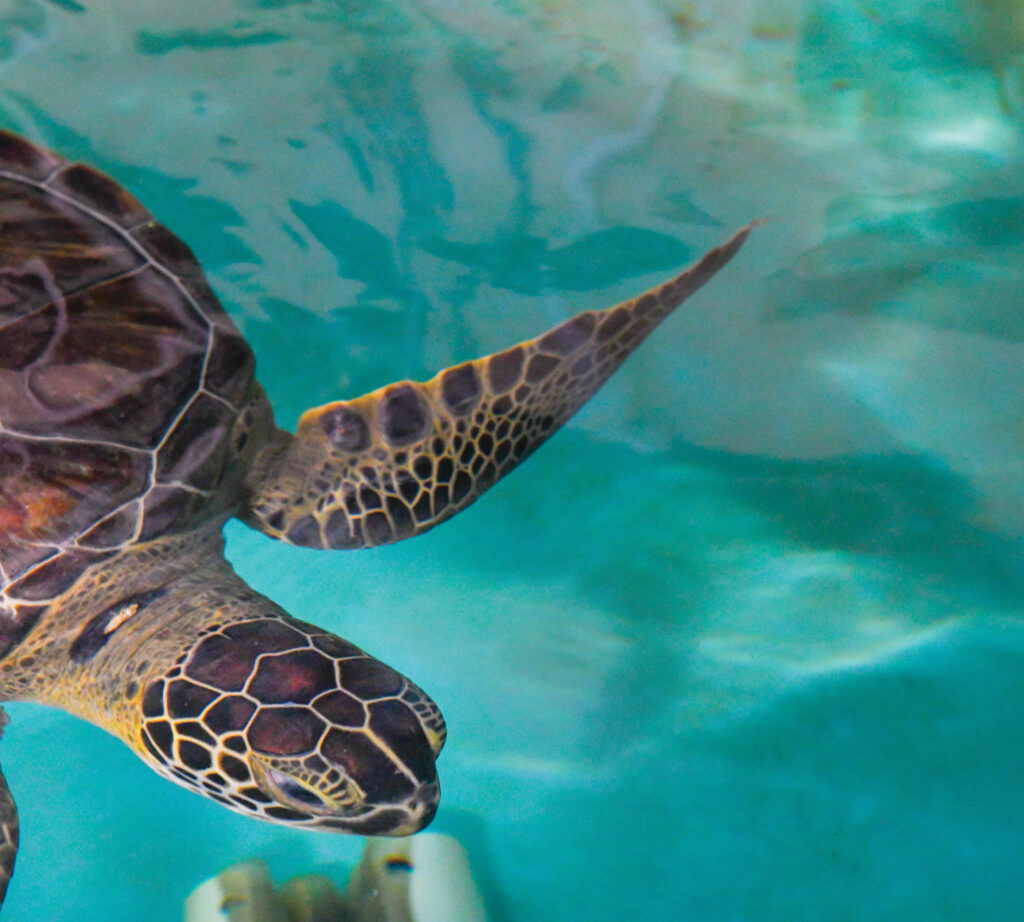
Saving Sea Turtles
Whitney Lab’s hospital treats sick, injured turtles while boosting research
On the operating table, the patient fidgeted under bright lights as the anesthesia slowly took hold. Soon, the medical team would use a carbon dioxide laser to precisely explode dangerous eye tumor cells.
The patient that November day was Adrift, an 8-pound, juvenile green sea turtle. Left unchecked, the virus-driven tumors would eventually affect Adrift’s vision — and perhaps the ability to swim effectively or avoid predators. An operating room whiteboard at the Whitney Lab’s Sea Turtle Hospital listed the recent cases: Adrift, Psycho, Beetlejuice and Pinocchio.
At the lab, sea turtles are its most iconic marine creatures. Residents scoop up stranded young turtles, dropping them off after hours into Tupperware containers left in a cooler. Schoolchildren get to know the turtles during educational visits. When a hurricane is looming, staff members shuttle the turtles to other facilities, the veterinarian’s house —or home with staff to ride out the storm
Among the staff and cadre of volunteers who keep the hospital running, nothing is overlooked. The turtles’ medical issues are documented in exceptional detail, including logging their stool habits. In the kitchen, a refrigerator is packed with cucumbers, green peppers and Romaine lettuce. Volunteers help to pump out precise, customized meals: 36 grams of seafood for Adrift in the mornings. Fish filets only for Psycho. For others, it’s mackerel, herring, squid or shrimp.
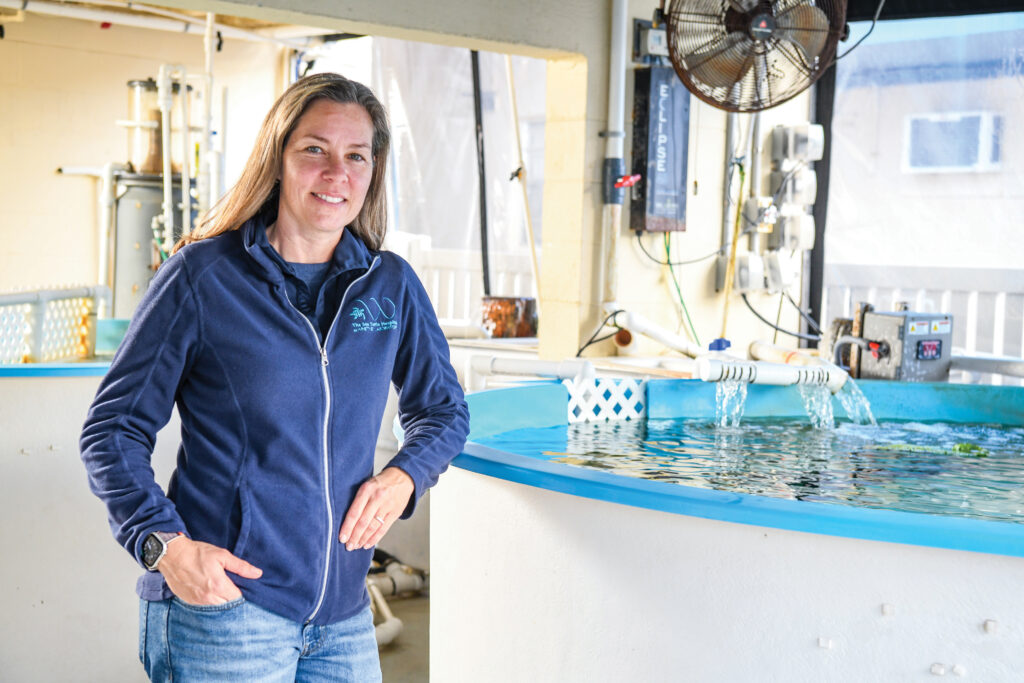
While most turtles spend six to nine months undergoing treatment and rehabilitation, program manager Catherine Eastman and four employees face a year-round onslaught. Hurricane season brings an influx of juvenile turtles that get washed back to shore. Summer is the season for net entanglements and fishing hook injuries.
In the winter, cold snaps can stun turtles. When a bitter weather front blasted Florida in late January, Whitney’s staff and volunteers met an unprecedented challenge. The Sea Turtle Hospital took in 119 cold-stunned turtles in three days, monitoring and treating them until they could be returned to the wild or sent to other facilities.
About a dozen years ago, Eastman pitched the idea of a sea turtle hospital. It was built on a shoestring — “Home Depot-style” she says — and now operates on a $350,000 annual budget. Eastman’s team makes the most of it, treating 199 injured or ill turtles and 243 hatchlings and post-hatchlings last year.
Over the years, Eastman’s team has gone to extraordinary lengths for her patients. Banana, a 70-pound turtle from Cocoa Beach, arrived in 2015 with severe neck injuries from a boat propeller. The gashed tendons kept Banana from supporting her head, but the team had a plan. They put out a public call for life jackets. The public responded with dozens of them.
The idea, Eastman says, was to sew a floating flap onto the life jacket and put it backwards onto Banana. Eastman just happens to be a big fan of MacGyver, the 1980s television series featuring an ingenious problem solver. Before long, Banana’s chin was bobbing, just like Eastman hoped.
“It worked and we were all happy, but we had to do so much problem solving,” she says.
Yet education and rehabilitation are just part of the equation, Eastman says. Having a sea turtle hospital embedded in a marine research lab benefits animals and humans alike. Whitney is the state’s only university-affiliated lab for treating turtles’ fibropapilloma tumors. Later this year, the turtle caregivers and many scientists will be under the same roof when Whitney’s new $41.2 million Marine Research Institute and Sea Turtle Research Center and Hospital opens.
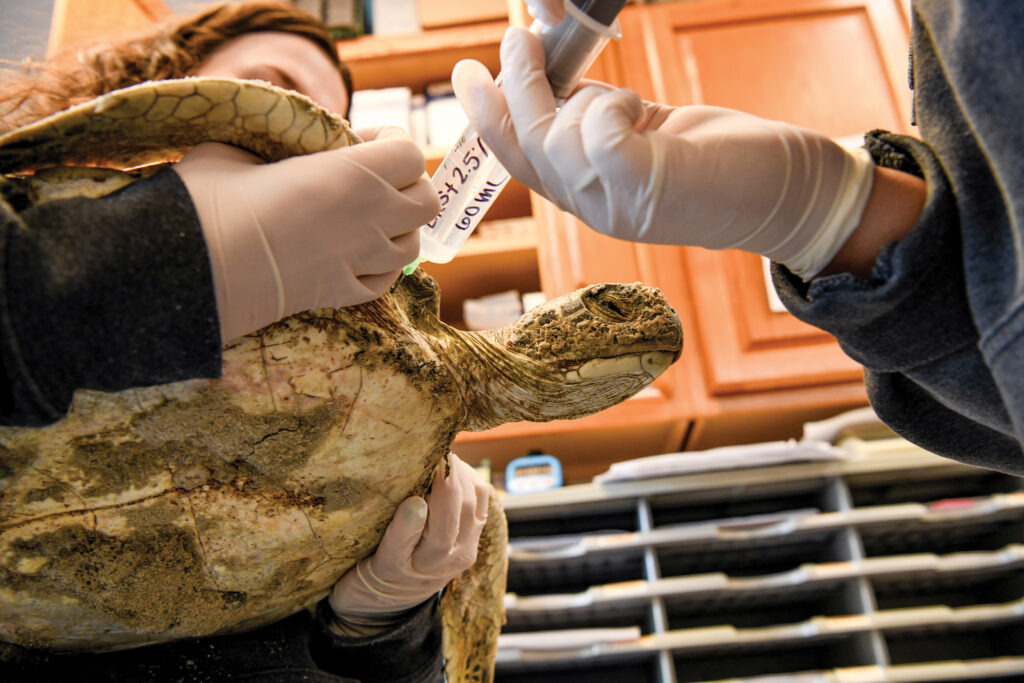
“It always feels good to rehabilitate and release animals back to the wild. But at the end of the day, research is where we can have a broader reach,” Eastman says.
That’s where David Duffy, a molecular biologist who researches fibropapillomatosis and other sea turtle issues, comes in. Duffy says he’s intensely interested in the factors that are driving a prolonged uptick in fibropapilloma tumors, which share some traits with human herpes viruses. He also collaborated with Eastman to reveal the prevalence of plastic ingestion in sea turtles — a project they say was facilitated by the sea turtle hospital being at Whitney.
Since 2015, Duffy has been using state-of-the-art genomic approaches from human cancer research and applying it to sea turtles to better understand their tumors. Some of the same types of genes are involved in human and turtle cancers, he found. He is also exploring new drug treatments for sea turtle tumors, particularly internal ones that are currently untreatable.
“The hope is that some of our findings can actually translate back from humans to sea turtles,” Duffy said.
Due to their relative longevity, sea turtles are an excellent, natural model for studying cancer.
“Sea turtles enable us to study cancers that form over prolonged periods of time and understand the contribution of environmental exposures to the tumor formation, all while treating their tumors and returning our recovered patients to the wild,” Duffy says.
Another concern is plastic’s toxic impact on sea turtles – not just the direct, physical effects of eating it but also whether chemicals are leaching into the animals. Whitney, Duffy says, catalyzes that kind of research by having turtle patients supply biological samples at the same site as cutting-edge microscope imaging, advanced molecular biology techniques and genomic research. Cancer normally isn’t common in sea turtles but they become more susceptible to tumors if their environment gets polluted enough.
“That should be a big lesson for humans, as we continue to contaminate our homes and environments with an ever-increasing amount of diverse contaminants,” Duffy says.
Ultimately, Duffy wants his work to be about healing habitats rather than just affected animals.
“I wish I didn’t have to be interested in wildlife diseases,” he says. “We get many sea turtle patients every year that need a lot of hands-on care. Restoring their environment means they’ll need a lot less help from humans.”
Sources
Barry W. Ache
Distinguished Professor Emeritus of Biology and Neuroscience
bwa@whitney.ufl.edu
David Duffy
Assistant Professor of Wildlife Disease Genomics
duffy@whitney.ufl.edu
Catherine Eastman
Sea Turtle Hospital Program Manager
cbeastman@whitney.ufl.edu
Veronica Hinman
Professor of Biology
veronica.hinman@whitney.ufl.edu
Sandra Loesgen
Associate Professor of Chemistry
sandra.loesgen@whitney.ufl.edu
Mark Q. Martindale
Professor of Biology
mqmartin@whitney.ufl.edu

